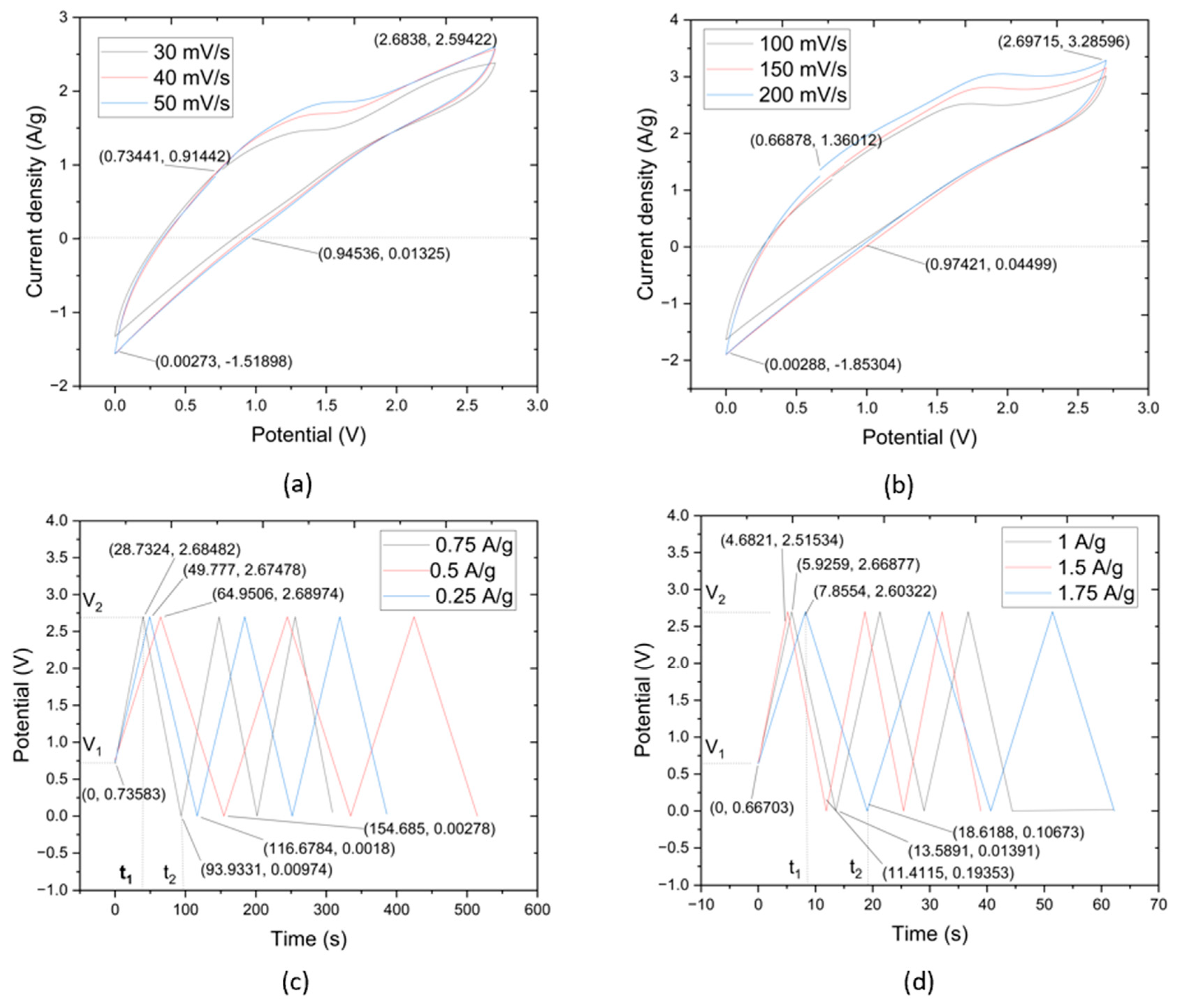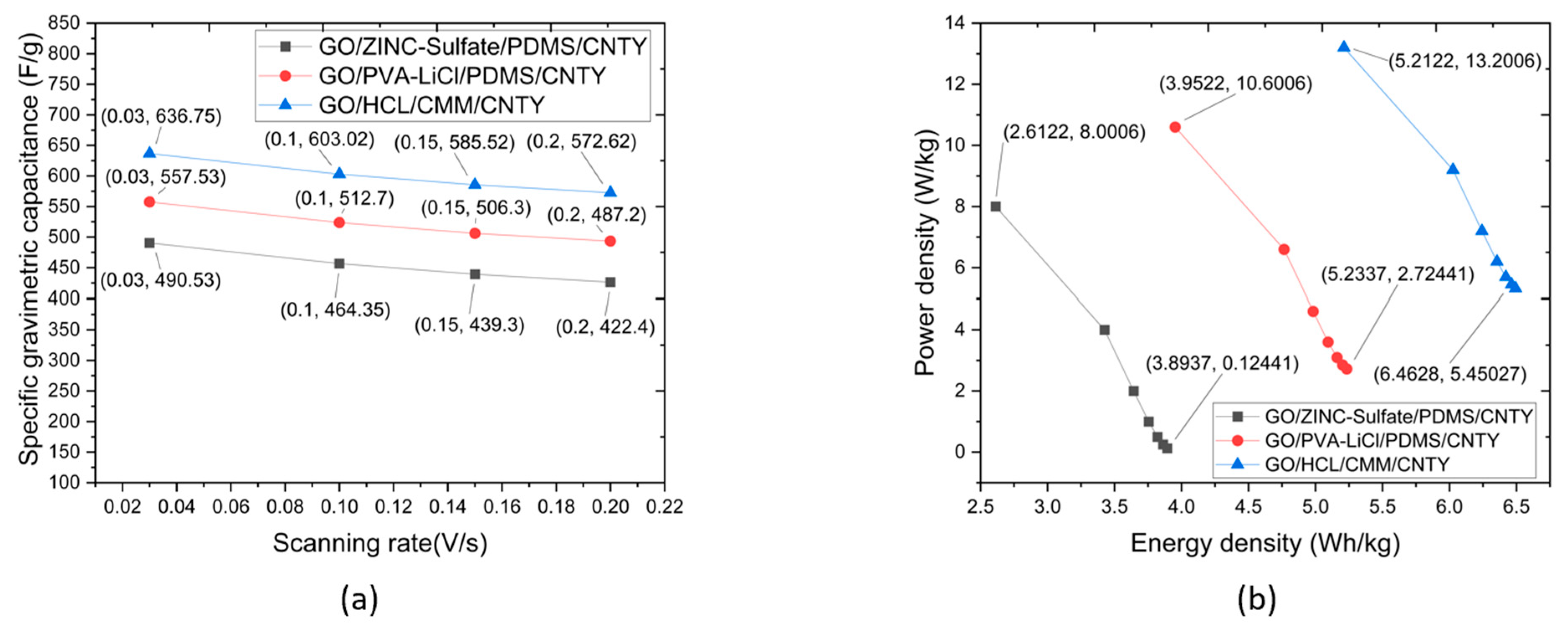Development of Carbon Nanotube Yarn Supercapacitors and Energy Storage for Integrated Structural Health Monitoring
Abstract
:1. Introduction
2. Materials and Methods
2.1. Materials and Sample Preparation
2.2. Preparation of Polydimethylsiloxane (PDMS)
2.3. Preparation of Graphene Oxide
2.4. Preparation Gel Electrolyte
2.5. Fabrication of CNTY-Based Supercapacitors
2.5.1. CNTYs Supercapacitor GO/HCL/CMM
2.5.2. CNTY Supercapacitor GO/Zinc Sulfate-PVA/LiCl/PDMS
2.6. Data Analysis and Interpretation
3. Results and Discussion
3.1. CNTY GO/Zinc Sulfate/PDMS/SCs
3.2. CNTY GO/PVA-LiCl/PDMS/SCs
3.3. CNTY GO/HCl/CMM/SCs
3.4. Capacitance, Energy, and Power Densities
4. Conclusions
Author Contributions
Funding
Data Availability Statement
Acknowledgments
Conflicts of Interest
References
- Tarascon, J.-M.; Armand, M. Issues and challenges facing rechargeable lithium batteries. Nature 2001, 414, 359–367. [Google Scholar] [CrossRef]
- Miller, J.R.; Simon, P. Electrochemical Capacitors for Energy Management. Science 2008, 321, 651–652. [Google Scholar] [CrossRef] [Green Version]
- Chen, H.; Cong, T.N.; Yang, W.; Tan, C.; Li, Y.; Ding, Y. Progress in electrical energy storage system: A critical review. Prog. Nat. Sci. 2009, 19, 291–312. [Google Scholar] [CrossRef]
- Skyllaskazacos, M.; Chakrabarti, M.H.; Hajimolana, S.A.; Mjalli, F.S.; Saleem, M. Progress in Flow Battery Research and Development. J. Electrochem. Soc. 2011, 158, R55–R79. [Google Scholar] [CrossRef]
- Janek, J.; Zeier, W.G. A solid future for battery development. Nat. Energy 2016, 1, 16141. [Google Scholar] [CrossRef]
- Simon, P.; Gogotsi, Y. Materials for electrochemical capacitors. Nat. Mater. 2008, 7, 845–854. [Google Scholar] [CrossRef] [PubMed] [Green Version]
- Conway, B.E. Electrochemical Supercapacitors. In Electrochemical Supercapacitors: Scientific Fundamentals and Technological Applications; Springer Science+Business Media: New York, NY, USA, 1999. [Google Scholar] [CrossRef]
- Salanne, M.; Rotenberg, B.; Naoi, K.; Kaneko, K.; Taberna, P.-L.; Grey, C.P.; Dunn, B.; Simon, P. Efficient storage mechanisms for building better supercapacitors. Nat. Energy 2016, 1, 16070. [Google Scholar] [CrossRef] [Green Version]
- Saito, R.; Dresselhaus, G.; Dresselhaus, M.S. Physical Properties of Carbon Nanotubes; World Scientific: Singapore, 1998. [Google Scholar] [CrossRef]
- Wu, A.S.; Nie, X.; Hudspeth, M.C.; Chen, W.W.; Chou, T.-W.; Lashmore, D.S.; Schauer, M.W.; Tolle, E.; Rioux, J. Strain rate-dependent tensile properties and dynamic electromechanical response of carbon nanotube fibers. Carbon 2012, 50, 3876–3881. [Google Scholar] [CrossRef]
- Saito, R.; Fujita, M.; Dresselhaus, G.; Dresselhaus, M.S. Electronic structure of chiral graphene tubules. Appl. Phys. Lett. 1992, 60, 2204–2206. [Google Scholar] [CrossRef]
- Cullinan, M.A.; Culpepper, M.L. Carbon nanotubes as piezoresistive microelectromechanical sensors: Theory and experiment. Phys. Rev. B 2010, 82, 115428. [Google Scholar] [CrossRef]
- Iijima, S. Helical microtubules of graphitic carbon. Nature 1991, 354, 56–58. [Google Scholar] [CrossRef]
- Novoselov, K.S.; Geim, A.K.; Morozov, S.V.; Jiang, D.; Katsnelson, M.I.; Grigorieva, I.V.; Dubonos, S.V.; Firsov, A.A. Two-dimensional gas of massless Dirac fermions in graphene. Nature 2005, 438, 197–200. [Google Scholar] [CrossRef] [Green Version]
- Cao, J.; Wang, Q.; Dai, H. Electromechanical Properties of Metallic, Quasimetallic, and Semiconducting Carbon Nanotubes under Stretching. Phys. Rev. Lett. 2003, 90, 157601. [Google Scholar] [CrossRef]
- Chang, N.-K.; Su, C.-C.; Chang, S.-H. Fabrication of single-walled carbon nanotube flexible strain sensors with high sensitivity. Appl. Phys. Lett. 2008, 92, 063501. [Google Scholar] [CrossRef]
- Zhang, X.; Jiang, K.; Feng, C.; Liu, P.; Zhang, L.; Kong, J.; Zhang, T.; Li, Q.; Fan, S. Spinning and Processing Continuous Yarns from 4-Inch Wafer Scale Super-Aligned Carbon Nanotube Arrays. Adv. Mater. 2006, 18, 1505–1510. [Google Scholar] [CrossRef]
- Behabtu, N.; Green, M.J.; Pasquali, M. Carbon nanotube-based neat fibers. Nano Today 2008, 3, 24–34. [Google Scholar] [CrossRef]
- Kang, I.; Schulz, M.J.; Kim, J.H.; Shanov, V.; Shi, D. A carbon nanotube strain sensor for structural health monitoring. Smart Mater. Struct. 2006, 15, 737–748. [Google Scholar] [CrossRef] [Green Version]
- Window, A.L. Strain Gauge Technology; Elsevier Applied Science: Amsterdam, The Netherlands, 1992. [Google Scholar]
- Liu, C. Foundations of MEMS: Pearson International Edition; Prentice Hall: Hoboken, NJ, USA, 2012. [Google Scholar]
- Dally, J.W.; Riley, W. Experimental Stress Analysis; McGraw-Hill: New York, NY, USA, 1991. [Google Scholar]
- Zheng, C.; Qian, W.; Cui, C.; Xu, G.; Zhao, M.; Tian, G.; Wei, F. Carbon nanotubes for supercapacitors: Consideration of cost and chemical vapor deposition techniques. J. Nat. Gas Chem. 2012, 21, 233–240. [Google Scholar] [CrossRef]
- Huang, G.; Hou, C.; Shao, Y.; Zhu, B.; Jia, B.; Wang, H.; Zhang, Q.; Li, Y. High-performance all-solid-state yarn supercapacitors based on porous graphene ribbons. Nano Energy 2015, 12, 26–32. [Google Scholar] [CrossRef]
- Xie, P.; Yuan, W.; Liu, X.; Peng, Y.; Yin, Y.; Li, Y.; Wu, Z. Advanced carbon nanomaterials for state-of-the-art flexible supercapacitors. Energy Storage Mater. 2020, 36, 56–76. [Google Scholar] [CrossRef]
- Abot, J.L.; Alosh, T.; Strain, K.B. Dependence of Electrical Resistance in Carbon Nanotube Yarns. Carbon 2014, 70, 95–102. [Google Scholar] [CrossRef]
- Li, Q.; Zhao, X.; Li, L.; Hu, T.; Yang, Y.; Zhang, J. Facile preparation of polydimethylsiloxane/carbon nanotubes modified melamine solar evaporators for efficient steam generation and desalination. J. Colloid Interface Sci. 2021, 584, 602–609. [Google Scholar] [CrossRef]
- Khan, M.; Tahir, M.N.; Adil, S.F.; Khan, H.U.; Siddiqui, M.R.H.; Al-Warthan, A.A.; Tremel, W. Graphene based metal and metal oxide nanocomposites: Synthesis, properties and their applications. J. Mater. Chem. A 2015, 3, 18753–18808. [Google Scholar] [CrossRef] [Green Version]
- Ashraf, M.; Shah, S.S.; Khan, I.; Aziz, A.; Ullah, N.; Khan, M.; Adil, S.F.; Liaqat, Z.; Usman, M.; Tremel, W.; et al. A High-Performance Asymmetric Supercapacitor Based on Tungsten Oxide Nanoplates and Highly Reduced Graphene Oxide Electrodes. Chem. A Eur. J. 2021, 27, 6973–6984. [Google Scholar] [CrossRef]
- Saleh, B.D.; Abdulwahhab, G.H.; Ahmed, S.M.R. Preparation and characterization of graphene oxide nanoparticles derived from wheat straw. Mater. Today Proc. 2023, 80, 860–869. [Google Scholar] [CrossRef]
- Hiraoka, T.; Izadi-Najafabadi, A.; Yamada, T.; Futaba, D.N.; Yasuda, S.; Tanaike, O.; Hatori, H.; Yumura, M.; Iijima, S.; Hata, K. Compact and Light Supercapacitor Electrodes from a Surface-Only Solid by Opened Carbon Nanotubes with 2 200 m2g−1 Surface Area. Adv. Funct. Mater. 2010, 20, 422–428. [Google Scholar] [CrossRef]
- Chua, C.K.; Pumera, M. Chemical reduction of graphene oxide: A synthetic chemistry viewpoint. Chem. Soc. Rev. 2014, 43, 291–312. [Google Scholar] [CrossRef]
- Zhou, G.; Yang, L.; Li, W.; Chen, C.; Liu, Q. A Regenerable Hydrogel Electrolyte for Flexible Supercapacitors. iScience 2020, 23, 101502. [Google Scholar] [CrossRef]
- Joseph, K.M.; Kasparian, H.J.; Shanov, V. Carbon Nanotube Fiber-Based Wearable Supercapacitors—A Review on Recent Advances. Energies 2022, 15, 6506. [Google Scholar] [CrossRef]
- Qi, Z.; Ye, J.; Chen, W.; Biener, J.; Duoss, E.B.; Spadaccini, C.M.; Worsley, M.A.; Zhu, C. 3D-Printed, Superelastic Polypyrrole–Graphene Electrodes with Ultrahigh Areal Capacitance for Electrochemical Energy Storage. Adv. Mater. Technol. 2018, 3, 1800053. [Google Scholar] [CrossRef]
- Shi, P.; Li, L.; Hua, L.; Qian, Q.; Wang, P.; Zhou, J.; Sun, G.; Huang, W. Design of Amorphous Manganese Oxide@Multiwalled Carbon Nanotube Fiber for Robust Solid-State Supercapacitor. ACS Nano 2016, 11, 444–452. [Google Scholar] [CrossRef] [PubMed]
- Yang, Z.; Deng, J.; Chen, X.; Ren, J.; Peng, H. A Highly Stretchable, Fiber-Shaped Supercapacitor. Angew. Chem. Int. Ed. 2013, 52, 13453–13457. [Google Scholar] [CrossRef] [PubMed]
- Lyu, X.; Su, F.; Miao, M. Two-ply yarn supercapacitor based on carbon nanotube/stainless steel core-sheath yarn electrodes and ionic liquid electrolyte. J. Power Sources 2016, 307, 489–495. [Google Scholar] [CrossRef]
- Zhang, D.H.; Miao, M.H.; Niu, H.T.; Wei, Z.X. Core-Spun Carbon Nanotube Yarn Supercapacitors for Wearable Electronic Textiles. Acs Nano 2014, 8, 4571–4579. [Google Scholar] [CrossRef]
- Dalton, A.B.; Collins, S.; Muñoz, E.; Razal, J.M.; Ebron, V.H.; Ferraris, J.P.; Coleman, J.N.; Kim, B.G.; Baughman, R.H. Su-per-tough carbon-nanotube fibres. Nature 2003, 423, 703. [Google Scholar] [CrossRef]
- Chen, X.; Lin, H.; Deng, J.; Zhang, Y.; Sun, X.; Chen, P.; Fang, X.; Zhang, Z.; Guan, G.; Peng, H. Electrochromic Fiber-Shaped Supercapacitors. Adv. Mater. 2014, 26, 8126–8132. [Google Scholar] [CrossRef] [PubMed]
- Cheng, X.; Fang, X.; Chen, P.; Doo, S.-G.; Son, I.H.; Huang, X.; Zhang, Y.; Weng, W.; Zhang, Z.; Deng, J.; et al. Designing one-dimensional supercapacitors in a strip shape for high performance energy storage fabrics. J. Mater. Chem. A 2015, 3, 19304–19309. [Google Scholar] [CrossRef]







| Study | Material | Potential (V) | Capacitance | Energy Density | Power Density | References |
|---|---|---|---|---|---|---|
| CNTY SC | GO-zinc sulfate-PDMS | 0.0–2.7 | 490.53 F/g at 1.75 A/g | 3.9 {Wh/kg] | 8 [W/kg] | |
| CNTY SC | GO-PVA-LiCl-PDMS | 0.0–2.7 | 557.53 F/g at 1.75 A/g | 5.2 [Wh/kg] | 10.6 [W/kg} | |
| CNTY SC | GO-HCl-CMM | 0.0–2.7 | 636.75 F/g at 1.75 A/g | 6.7 [Wh/kg] | 13.20 [W/kg] | |
| MnO2@MWCNTs SSLSc | PVA-LiCl | 0.0–1.0 | 8.5 F/cm3 at 1 A/cm3 | 0.96 [Wh/cm3] | 2.5 [W/cm3] | [36] |
| Elastic SC based on CNTs sheet + rubber fiber | PVA-H3PO4 | 0.0–0.8 | 19.2 [F/g] at 0.1 A/g | 0.363 [Wh/kg] | 421 [W/kg] | [37] |
| CNTs/SS core–sheath SC | PVDF-HFP-EMIMBF4 (IL) | 0.0–2.7 | 263.31 [F/cm3] at 0.1 V/s | 66.7 [mW h/cm3] | 8.89 [W/cm3] | [38] |
| Pt filament-based CNTs symmetric SC | PVA-H3PO4 | 0.0–1.0 | 241.3 [µF/cm] at 5 mV/s 86.2 [F/g] at 5 mV/s | 35.27 Wh/kg | 10.69 kW/kg | [39] |
| SWCNTs yarn SC | PVA-H3PO4 | 0.0–1.0 | 5 F/g | 0.6 Wh/kg | - | [40] |
| Electrochromic SC based on CNT/PANI + Elastic rubber FSSC | PVA-H3PO4 | 0.0–1.0 | 255.5 [F/g] at 1 A/g | 12.75 [Wh/kg] | 1494 [W/kg] | [41] |
| Strip-shape CNT/PANI SC | PVA-H3PO4 | 0.0–1.0 | 421.7 [F/cm3] at 0.5 A/cm | 9.6 [mWh/cm3] | 2.91 [W/cm3] | [42] |
Disclaimer/Publisher’s Note: The statements, opinions and data contained in all publications are solely those of the individual author(s) and contributor(s) and not of MDPI and/or the editor(s). MDPI and/or the editor(s) disclaim responsibility for any injury to people or property resulting from any ideas, methods, instructions or products referred to in the content. |
© 2023 by the authors. Licensee MDPI, Basel, Switzerland. This article is an open access article distributed under the terms and conditions of the Creative Commons Attribution (CC BY) license (https://creativecommons.org/licenses/by/4.0/).
Share and Cite
Binfaris, A.S.; Zestos, A.G.; Abot, J.L. Development of Carbon Nanotube Yarn Supercapacitors and Energy Storage for Integrated Structural Health Monitoring. Energies 2023, 16, 5736. https://doi.org/10.3390/en16155736
Binfaris AS, Zestos AG, Abot JL. Development of Carbon Nanotube Yarn Supercapacitors and Energy Storage for Integrated Structural Health Monitoring. Energies. 2023; 16(15):5736. https://doi.org/10.3390/en16155736
Chicago/Turabian StyleBinfaris, Abdulrahman S., Alexander G. Zestos, and Jandro L. Abot. 2023. "Development of Carbon Nanotube Yarn Supercapacitors and Energy Storage for Integrated Structural Health Monitoring" Energies 16, no. 15: 5736. https://doi.org/10.3390/en16155736







